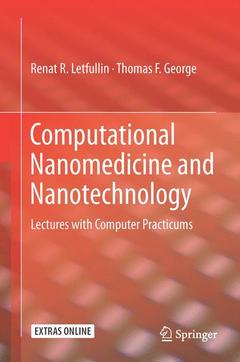Description
Computational Nanomedicine and Nanotechnology, Softcover reprint of the original 1st ed. 2016
Lectures with Computer Practicums
Authors: Letfullin Renat R., George Thomas F.
Language: English
Subjects for Computational Nanomedicine and Nanotechnology:
Approximative price 105.49 €
In Print (Delivery period: 15 days).
Add to cartPublication date: 02-2017
Support: Print on demand
Approximative price 105.49 €
In Print (Delivery period: 15 days).
Add to cartPublication date: 05-2018
Support: Print on demand
Description
/li>Contents
/li>Biography
/li>Comment
/li>
Thomas F. George is chancellor and professor of chemistry and physics at the University of Missouri–St. Louis. As chancellor, he oversees academic and administrative operations of a university with 17,000 students, 2,500 faculty and staff, 40 academic buildings and a $200 million annual operating budget. In addition, $150 million of new capital construction, renovation and landscaping on campus is taking place during 2014-16. The annual amount of philanthropic contributions during his tenure as chancellor have quadrupled to over $26 million, reaching as high as $31 million in 2014.
Chancellor George is active in the St. Louis community. He has received the Distinguished Higher Education Award from the Dr. Martin Luther King, Jr., Missouri State Celebration Commission, the Outstanding Community Service Award from the St. Louis County Branch of the National Association for the Advancement of Colored People, the Lifelong Vision Award from the Lifelong Vision Foundation of St. Louis, and the Silver Beaver Award and Good Scout Award from the Greater St. Louis Area Council of the Boy Scouts of America; and he has been named St. Louis North County Chamber of Commerce Citizen of the Year. He serves on numerous civic boards and currently is chair of the Higher Education Consortium of Metropolitan St. Louis, and he served for four years as chair of the Great Lakes Valley Conference (athletics). In addition to his role as campus and community leader and fund-raiser, Chancellor George contributes at the state and national levels, such as currently serving as vice-chair of the Council on Public Higher Education in Missouri and vice-president/treasurer of the Coalition of Metropolitan and Urban Universities (comprised of 95 institutions across the US and Canada).
Chancellor George is an active researcher in chemistry and physics, specializing in chemical/materials/laser physics and nanoscience, including nanomedicine. His work, supported by a wide var
Explains fundamental and advanced topics in nanomedicine and their applications, with a focus on nanophototherapy of cancer-related diseases
Provides complete instructions for using simulations effectively to predict nanoscale properties for real systems
Includes numerous exercises for each chapter as well as a computer practicum software developed for Maple
Guides readers through both experimental and theoretical aspects of computational nanoscience
Reinforces readers’ understanding of essential concepts with examples from empirical research in nanotechnology-based diagnostic and therapeutic applications in medicine




